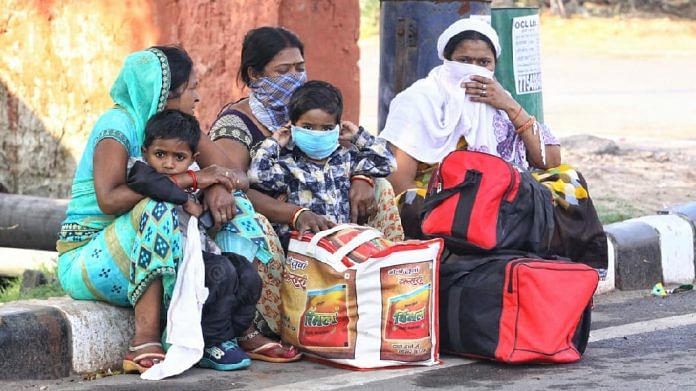The mainstream newspapers from The Times of India to Hindustan Times report that India had its highest casualty rates and jump in the number of Covid-19 cases Monday, while a New Delhi locality has become the new corona `hotspot’.
According to the papers, India still lags behind on testing but it is ordering and manufacturing more PPE (personal protective equipment) kits.
The pink papers report grim news of a bleak outlook for the financial year 2021 and the markets tumbling due to Covid-19.
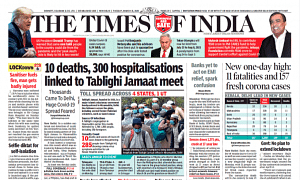 The lead story in The Times of India is ’10 deaths, 300 hospitalisations linked to Tablighi Jamaat meet’ — and the headline is enough to send shivers down your spine. A surge of cases emerged in Delhi’s Nizamuddin West locality, where a religious congregation was held earlier this month. “Nine Indians who attended – six in Telangana and one each in Tamil Nadu, Karnataka and J&K – have died of the disease… Of 25 new cases of Covid-19 that Delhi reported on Monday, 18 were from this seminary in Nizamuddin, said a senior official from the state health department. This takes the city’s tally of cases to 97”, reports TOI.
The lead story in The Times of India is ’10 deaths, 300 hospitalisations linked to Tablighi Jamaat meet’ — and the headline is enough to send shivers down your spine. A surge of cases emerged in Delhi’s Nizamuddin West locality, where a religious congregation was held earlier this month. “Nine Indians who attended – six in Telangana and one each in Tamil Nadu, Karnataka and J&K – have died of the disease… Of 25 new cases of Covid-19 that Delhi reported on Monday, 18 were from this seminary in Nizamuddin, said a senior official from the state health department. This takes the city’s tally of cases to 97”, reports TOI.
The other big lead is that India reported the highest number fatalities and cases reported Monday, with 11 fatalities and 157 fresh corona cases (`New one day high…’). According to TOI, “The previous highest single-day count of cases was on Sunday, when 130 new infections were reported from the states. On Monday, Kerala confirmed 32 new cases, followed by 25 cases in Delhi, 17 each in Maharashtra and Tamil Nadu and 16 new Covid-19 from Uttar Pradesh. The health ministry has confirmed total 1,251 cases and 32 deaths so far.”
And with a worrying headline, the daily notes, ‘No cars, exodus continues in carts’. Despite sealed borders, many migrant workers and labourers continued the journey back to their villages, on carts. “In a heartbreaking account, 35-year-old Kanhaiya Lal and his two friends — Anwar Ali (22) and Satyam (19). Vegetable vendors in Chandigarh, they were headed for their home in Kannauj, Uttar Pradesh. They said they had reached the Jewar toll plaza via Sonipat, Panipat, Malikpur, Dadri and Kasna road.“What do we do? We can’t die of hunger… ‘, said Kanhaiya Lal.”
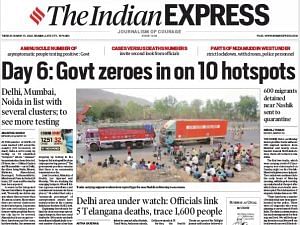 The Indian Express’ lead is different from TOI. Instead of dwelling on new cases or fatalities, its report, “Day 6: Govt zeroes in on 10 hotspots”, focuses on a new element in the coronavirus pandemic: clusters of Covid-19 cases across India, especially in Delhi, Mumbai and Noida that have been identified.
The Indian Express’ lead is different from TOI. Instead of dwelling on new cases or fatalities, its report, “Day 6: Govt zeroes in on 10 hotspots”, focuses on a new element in the coronavirus pandemic: clusters of Covid-19 cases across India, especially in Delhi, Mumbai and Noida that have been identified.
It also covers the connection between Covid-19 deaths in Telangana and a “gathering at a mosque” in Delhi’s Nizamuddin area (‘Delhi area under watch: Officials link 5 Telengana deaths, trace 1,600 people’). The six are part of the Tablighi Jamaat outfit and coronavirus cases in Tamil Nadu, Andaman islands and Kashmir have also been linked to the gathering, writes Express.
Another important read is the newspaper’s anchor story — a comprehensive analysis of all the Covid-19 cases from 10 states and the patients’ international travel history (‘Initial focus on China, Europe as virus sneaked in through Gulf’). The story notes that more than half of them had “come through or from Gulf nations” which means while India focused on barring travel from coronavirus-hit countries like China and Europe, the virus “sneaked in” through travellers coming from Gulf countries.
Ouch.
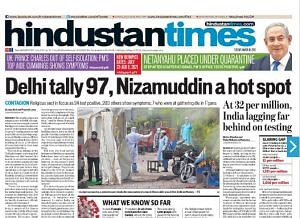 Like TOI, Hindustan Times‘ lead is Delhi’s Nizamuddin becoming a new hotspot. The paper says that the “first indications’’ of the problem were identified last week when officials in Andaman, Telangana, Tamil Nadu and Kashmir began tracing back travel histories of cases. Note the evocative photograph of an official checking the temperature of a man in a skull cap with a mask.
Like TOI, Hindustan Times‘ lead is Delhi’s Nizamuddin becoming a new hotspot. The paper says that the “first indications’’ of the problem were identified last week when officials in Andaman, Telangana, Tamil Nadu and Kashmir began tracing back travel histories of cases. Note the evocative photograph of an official checking the temperature of a man in a skull cap with a mask.
Also read the report, ‘At 32 per million, India lagging far behind on testing’. The daily reports, “Nearing a month after the wave of Covid-19 infections began in India, testing in the country is a 60th of that in the UK, a 82th of that in the US, and a 241th of that in South Korea, highlighting an area where India continues to lag. Although India has opened up testing to private laboratories — 47 of them — in addition to 127 government laboratories, questions remain about the availability of testing kits.”
HT also notes that `India orders more PPE kits as poor quality, shortage put health care workers in danger’. The story provides an example of the poor quality of PPE kits, “On March 28, the Indian Pilots’ Guild, a union of pilots at the state-owned airline Air India, wrote to the civil aviation minister and the company’s chairman complaining about the quality and quantity of personal protective equipment (PPE) on ‘recent rescue flights’ aimed at bringing back home Indians stuck overseas…Reuters reported last week, citing documents from India Invest, that the country needs 6.2 million units of PPE and has ‘approached hundreds of companies to secure supplies quickly’.”
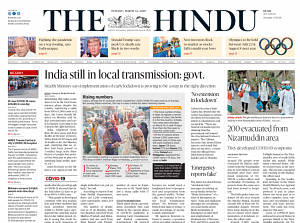 Here the lead story is entirely different from the other mainstream papers: ‘India still in local transmission: govt’. The daily reports, “Reiterating that India continues to be in the local transmission phase despite the country registering a spike from 100 to 1,000 cases in 12 days, the Union Health Ministry on Monday said India’s precautionary and early lockdown is proving to be a step in the right direction.”
Here the lead story is entirely different from the other mainstream papers: ‘India still in local transmission: govt’. The daily reports, “Reiterating that India continues to be in the local transmission phase despite the country registering a spike from 100 to 1,000 cases in 12 days, the Union Health Ministry on Monday said India’s precautionary and early lockdown is proving to be a step in the right direction.”
The Hindu is also the only mainstream paper to report on Page 1, the controversial `sanitising’ incident in Bareilly that came to light, Monday: ‘Migrant workers given mass disinfectant bath in Bareilly’. While action had been ordered against officials and those exposed to what appears to be bleach, the paper reports, “Migrant labourers returning to Bareilly were forced by the district administration to take an open-air bath with a disinfectant before being allowed entry into the district. Sodium hypochlorite solution, commonly used as a bleaching agent to remove stains, was used on the migrants, officials later admitted.”
The worrying part, as Hindu reports, is that one of the officials “is heard asking the migrants to close their eyes, telling them that the solution affects the face”.
There’s bad news for the country’s agriculture sectors, ‘Rabi harvest to be affected for want of farm workers’. The daily notes, “The lakhs of migrant workers streaming to their home villages… have left many farmers across the country bereft of agricultural labour just before the crucial harvesting season of the rabi or winter crop. Farmers also worry about government procurement and their ability to sell their crops, given that many mandis or agricultural markets are still closed…”
Wheat, mustard, rabi, paddy, maize, chickpeas and soyabean are the major rabi crops.
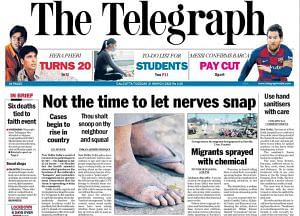 Giving HT competition for jarring photographs, The Telegraph has a photo of a man’s bruised and cut feet, as he makes his way to his village in the outskirts of Allahabad.
Giving HT competition for jarring photographs, The Telegraph has a photo of a man’s bruised and cut feet, as he makes his way to his village in the outskirts of Allahabad.
Also on the front page, news from the national capital, ‘Thou shalt snoop on thy neighbour and squeal’. The Kolkata daily reports, “Delhi police have asked residents’ welfare associations to spy and report on people stepping out for morning or evening walks, or even moving about on the compound, attracting charges of trying to create a ‘police state’. The advisory, which asks the RWAs to go through CCTV footage to identify those violating the lockdown, says people with valid reasons to step out will not face action.”
 In a reassuring lead story ‘Exodus Ebbs After Seal’, The New Indian Express says there was “semblance of normalcy across India” after the Centre “cracked the whip” on states to seal borders and impose a mandatory 14-day quarantine for curfew violators in view of the migrant exodus Monday. “The government also sought to quell rumours on the extension of the 21-day lockdown, with Cabinet Secretary Rajiv Gauba describing them as ‘fake news’. It was those rumours that had prodded migrants to leave Delhi in large numbers for their native places,” it adds.
In a reassuring lead story ‘Exodus Ebbs After Seal’, The New Indian Express says there was “semblance of normalcy across India” after the Centre “cracked the whip” on states to seal borders and impose a mandatory 14-day quarantine for curfew violators in view of the migrant exodus Monday. “The government also sought to quell rumours on the extension of the 21-day lockdown, with Cabinet Secretary Rajiv Gauba describing them as ‘fake news’. It was those rumours that had prodded migrants to leave Delhi in large numbers for their native places,” it adds.
The newspaper also wades into the Bareilly story with two photographs — it contrasts the former with a similar incident in Kerala, where it claims the migrants were sprayed with soap, not chemical.
In other shocking news: A deceased man’s relatives and neighbours in Villupuram, Tamil Nadu refused to bury the body for fears that they would contract the virus. The local story begins with the words “Suspicion is more infectious than any virus”.
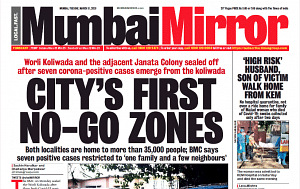 Mumbai Mirror, which is a Mumbai daily. reports on ‘CITY’S FIRST NO-GO ZONES’. According to the paper, “The BMC on Monday sealed the Worli Koliwada after three fresh Covid-19 positive cases emerged from the locality yesterday. Four cases were reported from the locality on Sunday, prompting the BMC officials to intensify contact-tracing. Police Commissioner Param Bir Singh visited the Worli Koliwada – one of the original seven islands of Mumbai and now a part of state Environment Minister Aaditya Thackeray’s constituency – to oversee the arrangements yesterday. Also sealed yesterday was Janata Colony, located around 500 mt from Worli Koliwada, making the localities Mumbai’s first no-go zones. Both localities are home to more than 35,000 people.”
Mumbai Mirror, which is a Mumbai daily. reports on ‘CITY’S FIRST NO-GO ZONES’. According to the paper, “The BMC on Monday sealed the Worli Koliwada after three fresh Covid-19 positive cases emerged from the locality yesterday. Four cases were reported from the locality on Sunday, prompting the BMC officials to intensify contact-tracing. Police Commissioner Param Bir Singh visited the Worli Koliwada – one of the original seven islands of Mumbai and now a part of state Environment Minister Aaditya Thackeray’s constituency – to oversee the arrangements yesterday. Also sealed yesterday was Janata Colony, located around 500 mt from Worli Koliwada, making the localities Mumbai’s first no-go zones. Both localities are home to more than 35,000 people.”
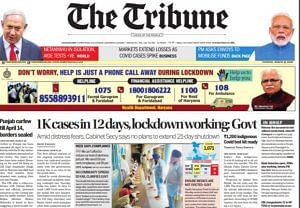 The Tribune leads with some positive news from the central government in “1K cases in 12 days, lockdown working: Govt”. It notes: “The first official analysis of the ongoing national lockdown has indicated positive results for Covid-19 containment with the government saying this is no time to let the guard down.”
The Tribune leads with some positive news from the central government in “1K cases in 12 days, lockdown working: Govt”. It notes: “The first official analysis of the ongoing national lockdown has indicated positive results for Covid-19 containment with the government saying this is no time to let the guard down.”
Tribune’s anchor story, ‘Haryana’s frontline soldiers battle Covid sans protective gear’, highlights the difficulties faced by medical staff in a district-level hospital in Haryana. It reports: “A doctor working in Gurugram said while they had been provided [personal protective equipment] PPE, nurses, who were equally at risk, had been left out. On Sunday, a video of a staff nurse, wearing a raincoat and shoes covered with polythene bags, working with a PHC in old Panchkula had gone viral. While the nurse was wearing a surgical mask, 4-5 Asha workers standing next to her, didn’t have any.”
 The Economic Times’ lead story, ‘Tax and Duty Relief Likely in Package for Industry’ suggests India is taking necessary steps in addressing coronavirus-hit industry sectors. It reports: India is close to finalising a second economic relief package that may include tax concessions for industry sectors hit hard by the disruption due to Covid-19, particularly micro, small and medium enterprises (MSMEs), services and exports. It also reports that India is “in talks” with the World Bank for assistance to bolster health infrastructure.
The Economic Times’ lead story, ‘Tax and Duty Relief Likely in Package for Industry’ suggests India is taking necessary steps in addressing coronavirus-hit industry sectors. It reports: India is close to finalising a second economic relief package that may include tax concessions for industry sectors hit hard by the disruption due to Covid-19, particularly micro, small and medium enterprises (MSMEs), services and exports. It also reports that India is “in talks” with the World Bank for assistance to bolster health infrastructure.
The rest of ET’s front page is peppered with sad news on various sectors. In “Labour-Driven Export Sectors Run for Cover”, the paper notes how cancelled orders, delayed shipments, missed payments and consignments stuck at ports have been major obstacles for the sector.
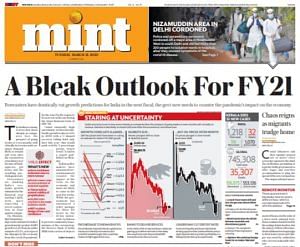 Mint leads with ‘A Bleak Outlook for FY21’ which is no less grim than yesterday’s headline that read ‘It’s A Long Slog For Bharat’. The pink paper puts the debilitating state of the economy in historical context and notes: “On Monday, S&P Global Ratings cut its estimate for India’s gross domestic product (GDP) growth to 3.5% from its earlier estimate of 5.2%, as it expects the damages to the economy from the covid-19 pandemic for the Asia-Pacific region to be as severe as the one during the Asian financial crisis of 1997-98.”
Mint leads with ‘A Bleak Outlook for FY21’ which is no less grim than yesterday’s headline that read ‘It’s A Long Slog For Bharat’. The pink paper puts the debilitating state of the economy in historical context and notes: “On Monday, S&P Global Ratings cut its estimate for India’s gross domestic product (GDP) growth to 3.5% from its earlier estimate of 5.2%, as it expects the damages to the economy from the covid-19 pandemic for the Asia-Pacific region to be as severe as the one during the Asian financial crisis of 1997-98.”
Another story, ‘FMCG companies run into logistics troubles’ says fast-moving consumer goods companies are facing an uphill battle. The companies “are in the process of resuming production, albeit at very limited capacities, even as the government moved to ease the supply of personal hygiene products,” it reports.
 Like The Hindu, Business Standard’s (‘Govt’s U-turn on ‘limited community transmission’) lead covers the Centre’s statement on local transmission of the virus in India. BS notes the Health Ministry’s mix-up of terminology. “A day after a health ministry document mentioned “limited community transmission” of the Covid-19 pandemic in the country, the government asserted on Monday it had reached only a ‘local transmission’ stage”. The report mentions that Health ministry’s Joint Secretary Lav Agarwal “cautioned against “going into the semantics” in context of the word “community” and, on a lighter vein, even said it would be dropped from future communication”.
Like The Hindu, Business Standard’s (‘Govt’s U-turn on ‘limited community transmission’) lead covers the Centre’s statement on local transmission of the virus in India. BS notes the Health Ministry’s mix-up of terminology. “A day after a health ministry document mentioned “limited community transmission” of the Covid-19 pandemic in the country, the government asserted on Monday it had reached only a ‘local transmission’ stage”. The report mentions that Health ministry’s Joint Secretary Lav Agarwal “cautioned against “going into the semantics” in context of the word “community” and, on a lighter vein, even said it would be dropped from future communication”.


